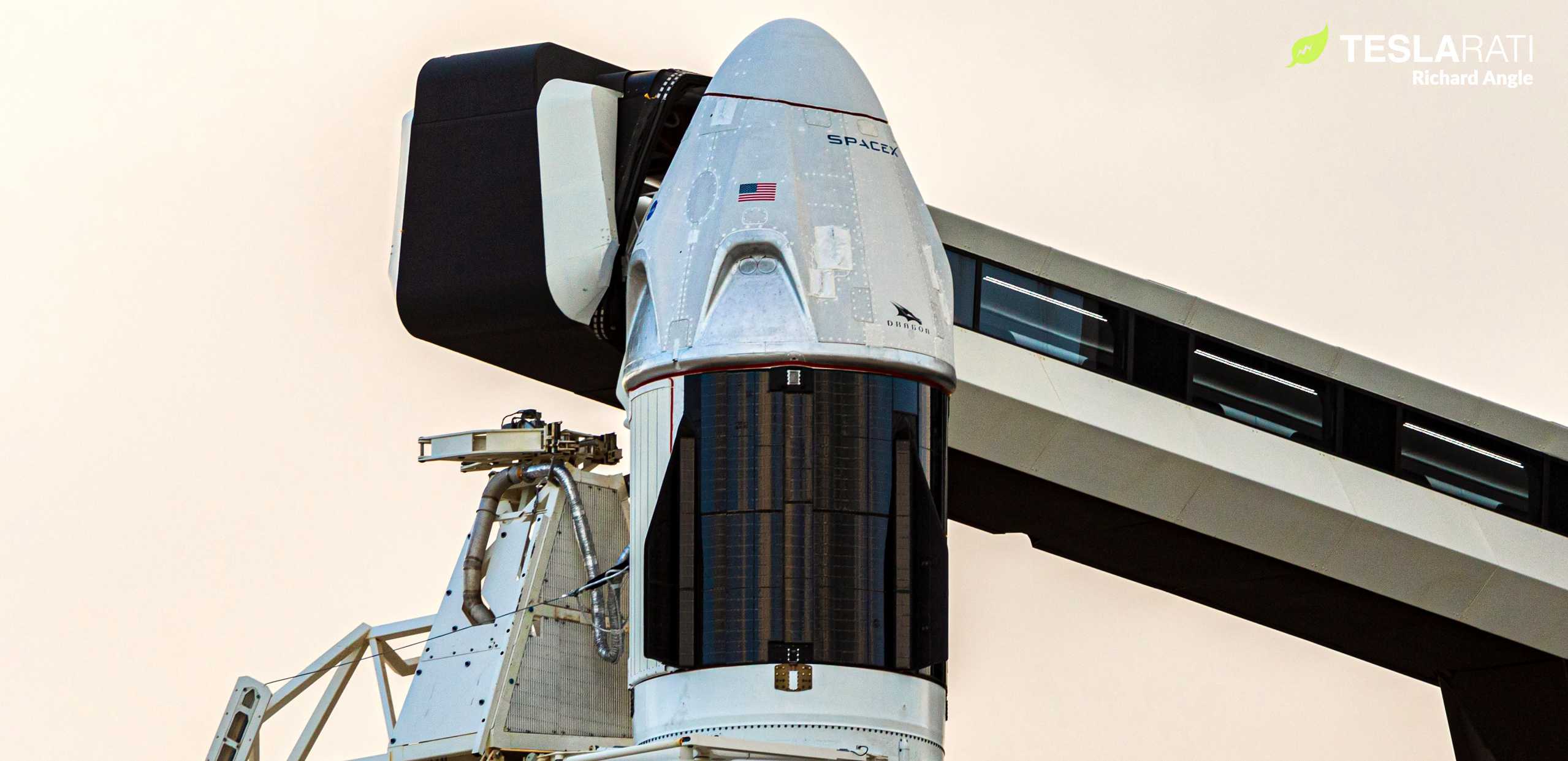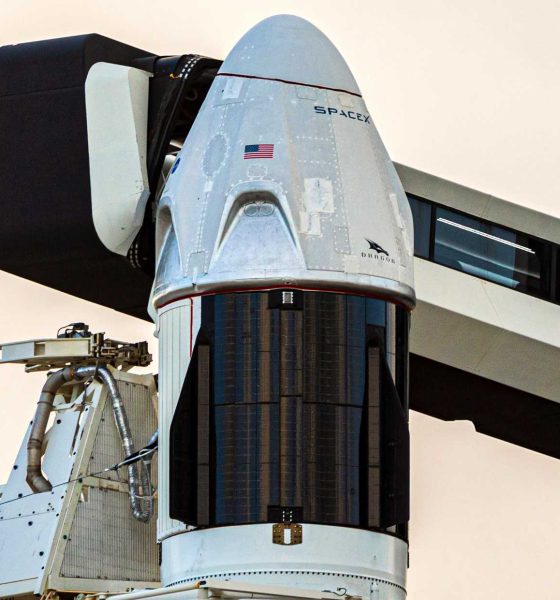

News
Elon Musk says SpaceX could catch Crew Dragon and NASA astronauts with a giant net
Shortly after SpaceX flawlessly completed Crew Dragon’s In-Flight Abort (IFA) test earlier today, CEO Elon Musk – speaking at a post-launch press conference – revealed that SpaceX wants to try to catch future Dragon spacecraft with the same ships – and giant nets – it uses to recover Falcon fairings.
This is not the first time Musk has mentioned such a plan. Back in February 2018, he noted that SpaceX ship Mr. Steven (now Ms. Tree), designed to catch parasailing fairing halves out of the air, “might be able to do the same thing with Dragon — if NASA wants us to, we can try to catch Dragon.” The motivation behind catching Dragon – instead of fishing it out of the Atlantic Ocean – is effectively the same reason that SpaceX is trying to routinely catch Falcon fairings: it’s much easier to reuse aerospace hardware that hasn’t been dunked and soaked in saltwater.
Of course, Musk cautioned that SpaceX would only pursue Dragon catches if NASA were open to the idea – the space agency’s conservatism is already largely responsible for the death of propulsive Crew Dragon landing, also intended to make spacecraft reuse much easier. Additionally, the CEO qualified his comments by noting that SpaceX would attempt to catch Crew Dragon only after Falcon fairing halves are being routinely and reliably caught.
As it turns out, both fairing recovery ships Ms. Tree and Ms. Chief are set to attempt their second simultaneous fairing catch less than 48 hours from now.
Ms. Tree and Ms. Chief actually departed their Port Canaveral home berths on the evening of January 18th, barely 12 hours before Falcon 9 B1046 lifted off for fourth and final time and was sacrificed for a thankfully flawless Crew Dragon abort test. The fast recovery ships – each outfitted with a giant net – are scheduled to attempt their second-ever simultaneous recovery of both halves of a Falcon 9 payload fairing.
Barely 48 hours after Crew Dragon’s IFA test, SpaceX has another Falcon 9 launch scheduled to lift off as early as 11:59 am EST (16:59 UTC) on Monday, January 21st. The mission will be SpaceX’s second Starlink satellite launch and third launch overall this month and is set to place the fourth batch of 60 Starlink internet satellites into low Earth orbit (LEO). Like all SpaceX satellite launches, the mission – Starlink V1 L3 or the third launch of Starlink v1.0 spacecraft – will feature a standard Falcon 9 fairing.
Around three minutes after liftoff, said fairing will separate into its two halves, deploying from the top of Falcon 9 and beginning a 100+ km (63+ mi) journey back to Earth. For SpaceX’s unique payload fairing, that journey includes reorienting with cold-gas thrusters, deploying a GPS-guided parafoil, and attempting to gently land in a giant net carried on the back off a ship.
Thus far, SpaceX has attempted to catch Falcon fairing halves nine separate times, resulting in two successful catches in June and August 2019. Two subsequent catch attempts in December 2019 and January 2020 were unsuccessful, a strong sign that SpaceX still has a ways to go before fairing catches are as routine and reliable as Falcon booster recovery.
As such, it’s unlikely that Ms. Tree or Ms. Chief will be catching Crew or Cargo Dragon capsules anytime soon. Still, it’s increasingly clear that every fairing catch attempt will also represent a potential step towards the goal of keeping Dragons and the NASA astronauts they’ll carry as dry as possible.
Check out Teslarati’s Marketplace! We offer Tesla accessories, including for the Tesla Cybertruck and Tesla Model 3.

News
Tesla aims to combat common Full Self-Driving problem with new patent
Tesla writes in the patent that its autonomous and semi-autonomous vehicles are heavily reliant on camera systems to navigate and interact with their environment.

Tesla is aiming to combat a common Full Self-Driving problem with a new patent.
One issue with Tesla’s vision-based approach is that sunlight glare can become a troublesome element of everyday travel. Full Self-Driving is certainly an amazing technology, but there are still things Tesla is aiming to figure out with its development.
Unfortunately, it is extremely difficult to get around this issue, and even humans need ways to combat it when they’re driving, as we commonly use sunglasses or sun visors to give us better visibility.
Cameras obviously do not have these ways to fight sunglare, but a new patent Tesla recently had published aims to fight this through a “glare shield.”
Tesla writes in the patent that its autonomous and semi-autonomous vehicles are heavily reliant on camera systems to navigate and interact with their environment.

The ability to see surroundings is crucial for accurate performance, and glare is one element of interference that has yet to be confronted.
Tesla described the patent, which will utilize “a textured surface composed of an array of micro-cones, or cone-shaped formations, which serve to scatter incident light in various directions, thereby reducing glare and improving camera vision.”

The patent was first spotted by Not a Tesla App.
The design of the micro-cones is the first element of the puzzle to fight the excess glare. The patent says they are “optimized in size, angle, and orientation to minimize Total Hemispherical Reflectance (THR) and reflection penalty, enhancing the camera’s ability to accurately interpret visual data.”
Additionally, there is an electromechanical system for dynamic orientation adjustment, which will allow the micro-cones to move based on the angle of external light sources.
This is not the only thing Tesla is mulling to resolve issues with sunlight glare, as it has also worked on two other ways to combat the problem. One thing the company has discussed is a direct photon count.
CEO Elon Musk said during the Q2 Earnings Call:
“We use an approach which is direct photon count. When you see a processed image, so the image that goes from the sort of photon counter — the silicon photon counter — that then goes through a digital signal processor or image signal processor, that’s normally what happens. And then the image that you see looks all washed out, because if you point the camera at the sun, the post-processing of the photon counting washes things out.”
Future Hardware iterations, like Hardware 5 and Hardware 6, could also integrate better solutions for the sunglare issue, such as neutral density filters or heated lenses, aiming to solve glare more effectively.
Elon Musk
Delaware Supreme Court reinstates Elon Musk’s 2018 Tesla CEO pay package
The unanimous decision criticized the prior total rescission as “improper and inequitable,” arguing that it left Musk uncompensated for six years of transformative leadership at Tesla.

The Delaware Supreme Court has overturned a lower court ruling, reinstating Elon Musk’s 2018 compensation package originally valued at $56 billion but now worth approximately $139 billion due to Tesla’s soaring stock price.
The unanimous decision criticized the prior total rescission as “improper and inequitable,” arguing that it left Musk uncompensated for six years of transformative leadership at Tesla. Musk quickly celebrated the outcome on X, stating that he felt “vindicated.” He also shared his gratitude to TSLA shareholders.
Delaware Supreme Court makes a decision
In a 49-page ruling Friday, the Delaware Supreme Court reversed Chancellor Kathaleen McCormick’s 2024 decision that voided the 2018 package over alleged board conflicts and inadequate shareholder disclosures. The high court acknowledged varying views on liability but agreed rescission was excessive, stating it “leaves Musk uncompensated for his time and efforts over a period of six years.”
The 2018 plan granted Musk options on about 304 million shares upon hitting aggressive milestones, all of which were achieved ahead of time. Shareholders overwhelmingly approved it initially in 2018 and ratified it once again in 2024 after the Delaware lower court struck it down. The case against Musk’s 2018 pay package was filed by plaintiff Richard Tornetta, who held just nine shares when the compensation plan was approved.
A hard-fought victory
As noted in a Reuters report, Tesla’s win avoids a potential $26 billion earnings hit from replacing the award at current prices. Tesla, now Texas-incorporated, had hedged with interim plans, including a November 2025 shareholder-approved package potentially worth $878 billion tied to Robotaxi and Optimus goals and other extremely aggressive operational milestones.
The saga surrounding Elon Musk’s 2018 pay package ultimately damaged Delaware’s corporate appeal, prompting a number of high-profile firms, such as Dropbox, Roblox, Trade Desk, and Coinbase, to follow Tesla’s exodus out of the state. What added more fuel to the issue was the fact that Tornetta’s legal team, following the lower court’s 2024 decision, demanded a fee request of more than $5.1 billion worth of TSLA stock, which was equal to an hourly rate of over $200,000.
Delaware Supreme Court Elon Musk 2018 Pay Package by Simon Alvarez
News
Tesla Cybercab tests are going on overdrive with production-ready units
Tesla is ramping its real-world tests of the Cybercab, with multiple sightings of the vehicle being reported across social media this week.

Tesla is ramping its real-world tests of the Cybercab, with multiple sightings of the autonomous two-seater being reported across social media this week. Based on videos of the vehicle that have been shared online, it appears that Cybercab tests are underway across multiple states.
Recent Cybercab sightings
Reports of Cybercab tests have ramped this week, with a vehicle that looked like a production-ready prototype being spotted at Apple’s Visitor Center in California. The vehicle in this sighting was interesting as it was equipped with a steering wheel. The vehicle also featured some changes to the design of its brake lights.
The Cybercab was also filmed testing at the Fremont factory’s test track, which also seemed to involve a vehicle that looked production-ready. This also seemed to be the case for a Cybercab that was spotted in Austin, Texas, which happened to be undergoing real-world tests. Overall, these sightings suggest that Cybercab testing is fully underway, and the vehicle is really moving towards production.
Production design all but finalized?
Recently, a near-production-ready Cybercab was showcased at Tesla’s Santana Row showroom in San Jose. The vehicle was equipped with frameless windows, dual windshield wipers, powered butterfly door struts, an extended front splitter, an updated lightbar, new wheel covers, and a license plate bracket. Interior updates include redesigned dash/door panels, refined seats with center cupholders, updated carpet, and what appeared to be improved legroom.
There seems to be a pretty good chance that the Cybercab’s design has been all but finalized, at least considering Elon Musk’s comments at the 2025 Annual Shareholder Meeting. During the event, Musk confirmed that the vehicle will enter production around April 2026, and its production targets will be quite ambitious.








